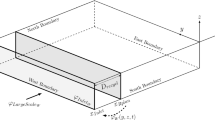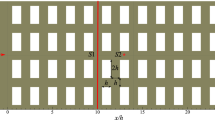Abstract
Precise urban atmospheric boundary layer (ABL) wind tunnel simulations are essential for a wide variety of atmospheric studies in built-up environments including wind loading of structures and air pollutant dispersion. One of key issues in addressing these problems is a proper choice of simulation length scale. In this study, an urban ABL was reproduced in a boundary layer wind tunnel at different scales to study possible scale effects. Two full-depth simulations and one part-depth simulation were carried out using castellated barrier wall, vortex generators, and a fetch of roughness elements. Redesigned “Counihan” vortex generators were employed in the part-depth ABL simulation. A hot-wire anemometry system was used to measure mean velocity and velocity fluctuations. Experimental results are presented as mean velocity, turbulence intensity, Reynolds stress, integral length scale of turbulence, and power spectral density of velocity fluctuations. Results suggest that variations in length-scale factor do not influence the generated ABL models when using similarity criteria applied in this study. Part-depth ABL simulation compares well with two full-depth ABL simulations indicating the truncated vortex generators developed for this study can be successfully employed in urban ABL part-depth simulations.











Similar content being viewed by others
Abbreviations
- b G :
-
vortex generator width
- d :
-
displacement height
- f :
-
frequency
- f M :
-
peak frequency
- h :
-
object height
- h G :
-
vortex generator height
- l :
-
large eddy mean size
- l G :
-
vortex generator length
- t :
-
time
- u :
-
absolute velocity in the x-direction
- \( \bar u \) :
-
mean velocity component in the x-direction
- \( {\bar u_z} \) :
-
mean velocity component in the x-direction at height z
- u τ :
-
friction velocity
- \( {\bar u_{ref}} \) :
-
reference velocity
- \( {\bar u_\delta } \) :
-
freestream velocity
- u′,v′,w′ :
-
fluctuating velocity component in the x-, y-, z-direction
- x :
-
distance in the direction of the flow
- y :
-
spanwise distance from test section centerplane
- z :
-
vertical distance from wind tunnel floor
- z ref :
-
reference height
- z 0 :
-
aerodynamic surface roughness length
- I u :
-
turbulence intensity in the x-direction
- Je :
-
Jensen number
- L u,x :
-
longitudinal integral length scale of turbulence
- Re R :
-
roughness Reynolds number
- R u,x :
-
longitudinal correlation coefficient
- S :
-
length scale factor
- S u (f):
-
power spectrum of longitudinal velocity fluctuations
- T :
-
total record length
- α :
-
power law exponent
- δ :
-
boundary layer thickness
- κ :
-
von Karman constant
- λ :
-
similarity coefficient
- ρ :
-
air density
- σ u :
-
standard deviation of u
- τ :
-
Reynolds stress
- v :
-
air viscosity
- m:
-
model (wind tunnel)
- p:
-
prototype (full-scale)
References
Arya SP (1999) Air pollution meteorology and dispersion. Oxford University Press, Oxford
Avissar R, Moran MD, Wu G, Meroney RN, Pielke RA (1990) Operating ranges of mesoscale numerical models and meteorological wind tunnels for the simulation of sea and land breezes. Bound-Lay Meteorol 50:227–275
Balendra T, Shah DA, Tey KL, Kong SK (2002) Evaluation of flow characteristics in the NUS-HDB Wind Tunnel. J Wind Eng Ind Aerod 90:675–688
Becker S, Lienhart H, Durst F (2002) Flow around three-dimensional obstacles in boundary layers. J Wind Eng Ind Aerod 90:265–279
Bendat JS, Piersol AG (2000) Random data: analysis and measurement procedures. Wiley, New York
Businger JA, Wyngaard JC, Izumi Y, Bradley EF (1971) Flux-profile relationships in the atmospheric surface layer. J Atmos Sci 28:181–189
Cook NJ (1973) On simulating the lower third of the urban adiabatic boundary layer in a wind tunnel. Atmos Environ 7:691–105
Cook NJ (1978) Determination of the model scale factor in wind-tunnel simulations of the adiabatic atmospheric boundary layer. J Wind Eng Ind Aerod 2(4):311–321
Counihan J (1969a) A method of simulating a neutral atmospheric boundary layer in a wind tunnel. AGARD Conf. Proc. 43
Counihan J (1969b) An improved method of simulating an atmospheric boundary layer in a wind tunnel. Atmos Environ 3:197–214
Counihan J (1971) Wind tunnel determination of the roughness length as a function of the fetch and the roughness density of three-dimensional roughness elements. Atmos Environ 5:637–642
Counihan J (1972) The structure and the wind tunnel simulation of rural and urban adiabatic boundary layers. Symp. External Flows, University of Bristol
Counihan J (1973) Simulation of an adiabatic urban boundary layer in a wind tunnel. Atmos Environ 7:673–689
Counihan J (1975) Adiabatic atmospheric boundary layers: a review and analysis of data from the period 1880–1972. Atmos Environ 9:871–905
De Bortoli ME, Natalini B, Paluch MJ, Natalini MB (2002) Part-depth wind tunnel simulations of the atmospheric boundary layer. J Wind Eng Ind Aerod 90(4–5):281–291
Dyrbye C, Hansen S (1997) Wind loads on structures. Wiley, New York
ESDU (1975) Characteristics of atmospheric turbulence near the ground, Part II: single point data for strong winds (neutral atmosphere). In: Engineering Sciences Data Unit 74031
ESDU (1985) Characteristics of wind speed in the lower layers of the atmosphere near the ground: strong winds (neutral atmosphere). In: Engineering Sciences Data Unit 85020
Garratt JR (1992) The atmospheric boundary layer. Cambridge University Press, New York
Farell C, Iyengar AKS (1999) Experiments on the wind tunnel simulation of atmospheric boundary layers. J Wind Eng Ind Aerod 79:11–35
Gartshore IS, De Croos KA (1977) Roughness element geometry required for wind tunnel simulations of the atmospheric wind. J Fluid Eng 9:480–485
Grimmond CSB, Oke TR (1999) Aerodynamic properties of urban areas derived from analysis of surface form. J Appl Meteorol 38:1262–1292
Hogstrom U (1988) Non-dimensional wind and temperature profiles in the atmospheric surface layer, a re-evaluation. Bound-Lay Meteorol 42:55–78
Hucho W-H (2002) Aerodynamik der stumpfen Körper. Vieweg & Sohn, Wiesbaden
Hunt A (1981) scale effects on wind tunnel measurements of surface pressures on model buildings. In: Proceedings of the Colloquium “Designing with the Wind”, CSTB, Nantes, France
Iyengar AKS, Farell C (2001) Experimental issues in atmospheric boundary layer simulations: roughness length and integral length scale determination. J Wind Eng Ind Aerod 89:1059–1080
Jensen M (1958) The model law phenomena in natural wind. Ingenioren 2(4):121–128
Jia Y, Sill BL, Reinhold TA (1998) Effects of surface roughness element spacing on boundary-layer velocity profile parameters. J Wind Eng Ind Aerod 73:215–230
Kolmogorov AN (1941) The local structure of turbulence in incompressible viscous fluid for very large Reynolds numbers. Proceedings of the Academy of Sciences of the USSR 30:299–303
Kozmar H (2008) Influence of spacing between buildings on wind characteristics above rural and suburban areas. Wind Struct 11(5):413–426
Kozmar H, Džijan I, Šavar M (2005) Uniformity of atmospheric boundary layer model in the wind tunnel (in Croatian). Strojarstvo 47(5–6):157–167
Lettau H (1969) Note on aerodynamic roughness-parameter estimation on the basis of roughness-element description. J Appl Meteorol 8:828–832
Melbourne WH (1979) Turbulence effect on maximum surface pressures – a mechanism and possibility of reduction. In: Proceedings of the Fifth International Conference on Wind Engineering, Fort Collins, Colorado, U.S.A.
Pasquill F (1961) The estimation of the dispersion of windborne material. Meteor Mag 90:33–49
Peterka JA, Hosoya N, Dodge S, Cochran L, Cermak JE (1998) Area-average peak pressures in a gable roof vortex region. J Wind Eng Ind Aerod 77–78(1):205–215
Plate EJ (1982) Engineering meteorology. Elsevier, Amsterdam
Reinhold TA, Tieleman HW, Maher FJ (1978) Simulation of the urban neutral boundary layer for the model study of wind loads on tall buildings. Department of Engineering Science and Mechanics, Virginia Polytechnic Institute and State University, Report VPI-E-77-12
Robins AG (1979) The development and structure of simulated neutrally stable atmospheric boundary layers. J Wind Eng Ind Aerod 4:71–100
Schlichting H, Gersten K (1996) Grenzschicht-Theorie. Springer, Berlin
Scire JS, Hanna SR (1992) An atmospheric boundary layer stability estimator for urban areas. SBIR phase I feasibility study. Sigma Research Corporation. Report Under Contract DAAD07-91-C-0135
Stathopoulos T, Surry D (1983) Scale effects in wind tunnel testing of low buildings. J Wind Eng Ind Aerod 13:313–326
Surry D (1982) Consequences of distortions in the flow including mismatching scale and intensities of turbulence. Presented at the International Workshop on Wind Tunnel Modeling for Civil Engineering Applications, U.S. Dept. of Commerce, National Bureau of Standards, Gaithersburg, MD, U.S.A.
Thuillier RH, Lappe UO (1964) Wind and temperature profile characteristics from observations on a 1400 ft tower. J Appl Meteorol 3:299–306
Vickery PJ (1981) A wind tunnel study on a model of the full scale experimental house at Aylesbury, England. B.E.Sc. Thesis, Faculty of Engineering Science, The University of Western Ontario, London, Canada
Von Karman T (1948) Progress in the statistical theory of turbulence. In: Proc. Nat. Acad. Sci., Washington, DC, 530–539
Wang ZY, Plate EJ, Rau M, Keiser R (1996) Scale effects in wind tunnel modeling. J Wind Eng Ind Aerod 61:113–130
Acknowledgements
This work was conducted in the Institute of Aerodynamics, Technische Universität München. The support of the Croatian Ministry of Science and Technology, the German Academic Exchange Service (DAAD), and the Croatian Academy of Sciences and Arts (HAZU) is gratefully acknowledged. The author acknowledges many helpful discussions with Prof. Boris Laschka, Dr. Albert Pernpeintner, and Dr. Joseph Fischer. Special thanks needs to be expressed to the TUM departmental technical staff for the manufacturing of the simulation hardware. The Fulbright Foundation supported a research stay at the University of Notre Dame.
Author information
Authors and Affiliations
Corresponding author
Rights and permissions
About this article
Cite this article
Kozmar, H. Scale effects in wind tunnel modeling of an urban atmospheric boundary layer. Theor Appl Climatol 100, 153–162 (2010). https://doi.org/10.1007/s00704-009-0156-3
Received:
Accepted:
Published:
Issue Date:
DOI: https://doi.org/10.1007/s00704-009-0156-3




